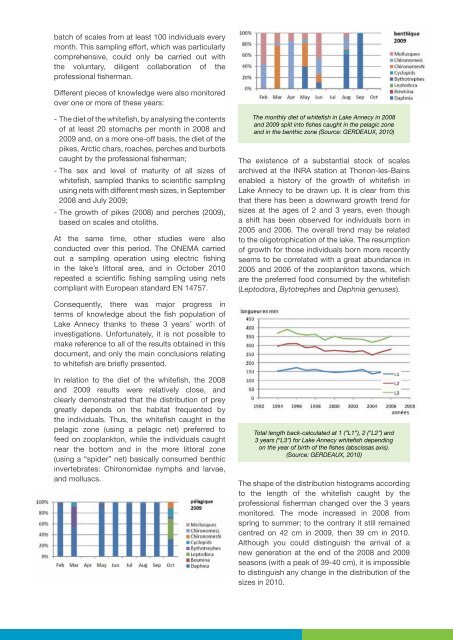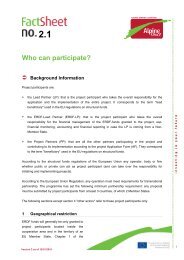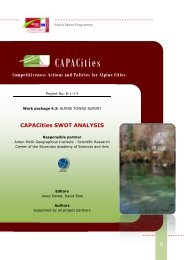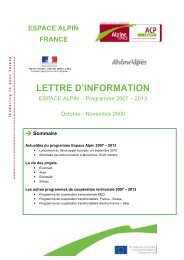Sustainable management of leisure and professional fisheries at the ...
Sustainable management of leisure and professional fisheries at the ...
Sustainable management of leisure and professional fisheries at the ...
Create successful ePaper yourself
Turn your PDF publications into a flip-book with our unique Google optimized e-Paper software.
<strong>at</strong>ch <strong>of</strong> scales from <strong>at</strong> least 100 individuals every<br />
month. This sampling effort, which was particularly<br />
comprehensive, could only be carried out with<br />
<strong>the</strong> voluntary, diligent collabor<strong>at</strong>ion <strong>of</strong> <strong>the</strong><br />
pr<strong>of</strong>essional fisherman.<br />
Different pieces <strong>of</strong> knowledge were also monitored<br />
over one or more <strong>of</strong> <strong>the</strong>se years:<br />
- The diet <strong>of</strong> <strong>the</strong> whitefish, by analysing <strong>the</strong> contents<br />
<strong>of</strong> <strong>at</strong> least 20 stomachs per month in 2008 <strong>and</strong><br />
2009 <strong>and</strong>, on a more one-<strong>of</strong>f basis, <strong>the</strong> diet <strong>of</strong> <strong>the</strong><br />
pikes, Arctic chars, roaches, perches <strong>and</strong> burbots<br />
caught by <strong>the</strong> pr<strong>of</strong>essional fisherman;<br />
- The sex <strong>and</strong> level <strong>of</strong> m<strong>at</strong>urity <strong>of</strong> all sizes <strong>of</strong><br />
whitefish, sampled thanks to scientific sampling<br />
using nets with different mesh sizes, in September<br />
2008 <strong>and</strong> July 2009;<br />
- The growth <strong>of</strong> pikes (2008) <strong>and</strong> perches (2009),<br />
based on scales <strong>and</strong> otoliths.<br />
At <strong>the</strong> same time, o<strong>the</strong>r studies were also<br />
conducted over this period. The ONEMA carried<br />
out a sampling oper<strong>at</strong>ion using electric fishing<br />
in <strong>the</strong> lake’s littoral area, <strong>and</strong> in October 2010<br />
repe<strong>at</strong>ed a scientific fishing sampling using nets<br />
compliant with European st<strong>and</strong>ard EN 14757.<br />
The monthly diet <strong>of</strong> whitefish in Lake Annecy in 2008<br />
<strong>and</strong> 2009 split into fishes caught in <strong>the</strong> pelagic zone<br />
<strong>and</strong> in <strong>the</strong> benthic zone (Source: GERDEAUX, 2010)<br />
The existence <strong>of</strong> a substantial stock <strong>of</strong> scales<br />
archived <strong>at</strong> <strong>the</strong> INRA st<strong>at</strong>ion <strong>at</strong> Thonon-les-Bains<br />
enabled a history <strong>of</strong> <strong>the</strong> growth <strong>of</strong> whitefish in<br />
Lake Annecy to be drawn up. It is clear from this<br />
th<strong>at</strong> <strong>the</strong>re has been a downward growth trend for<br />
sizes <strong>at</strong> <strong>the</strong> ages <strong>of</strong> 2 <strong>and</strong> 3 years, even though<br />
a shift has been observed for individuals born in<br />
2005 <strong>and</strong> 2006. The overall trend may be rel<strong>at</strong>ed<br />
to <strong>the</strong> oligotrophic<strong>at</strong>ion <strong>of</strong> <strong>the</strong> lake. The resumption<br />
<strong>of</strong> growth for those individuals born more recently<br />
seems to be correl<strong>at</strong>ed with a gre<strong>at</strong> abundance in<br />
2005 <strong>and</strong> 2006 <strong>of</strong> <strong>the</strong> zooplankton taxons, which<br />
are <strong>the</strong> preferred food consumed by <strong>the</strong> whitefish<br />
(Leptodora, Bytotrephes <strong>and</strong> Daphnia genuses).<br />
Consequently, <strong>the</strong>re was major progress in<br />
terms <strong>of</strong> knowledge about <strong>the</strong> fish popul<strong>at</strong>ion <strong>of</strong><br />
Lake Annecy thanks to <strong>the</strong>se 3 years’ worth <strong>of</strong><br />
investig<strong>at</strong>ions. Unfortun<strong>at</strong>ely, it is not possible to<br />
make reference to all <strong>of</strong> <strong>the</strong> results obtained in this<br />
document, <strong>and</strong> only <strong>the</strong> main conclusions rel<strong>at</strong>ing<br />
to whitefish are briefly presented.<br />
In rel<strong>at</strong>ion to <strong>the</strong> diet <strong>of</strong> <strong>the</strong> whitefish, <strong>the</strong> 2008<br />
<strong>and</strong> 2009 results were rel<strong>at</strong>ively close, <strong>and</strong><br />
clearly demonstr<strong>at</strong>ed th<strong>at</strong> <strong>the</strong> distribution <strong>of</strong> prey<br />
gre<strong>at</strong>ly depends on <strong>the</strong> habit<strong>at</strong> frequented by<br />
<strong>the</strong> individuals. Thus, <strong>the</strong> whitefish caught in <strong>the</strong><br />
pelagic zone (using a pelagic net) preferred to<br />
feed on zooplankton, while <strong>the</strong> individuals caught<br />
near <strong>the</strong> bottom <strong>and</strong> in <strong>the</strong> more littoral zone<br />
(using a “spider” net) basically consumed benthic<br />
invertebr<strong>at</strong>es: Chironomidae nymphs <strong>and</strong> larvae,<br />
<strong>and</strong> molluscs.<br />
Total length back-calcul<strong>at</strong>ed <strong>at</strong> 1 (“L1”), 2 (“L2”) <strong>and</strong><br />
3 years (“L3”) for Lake Annecy whitefish depending<br />
on <strong>the</strong> year <strong>of</strong> birth <strong>of</strong> <strong>the</strong> fishes (abscissas axis).<br />
(Source: GERDEAUX, 2010)<br />
The shape <strong>of</strong> <strong>the</strong> distribution histograms according<br />
to <strong>the</strong> length <strong>of</strong> <strong>the</strong> whitefish caught by <strong>the</strong><br />
pr<strong>of</strong>essional fisherman changed over <strong>the</strong> 3 years<br />
monitored. The mode increased in 2008 from<br />
spring to summer; to <strong>the</strong> contrary it still remained<br />
centred on 42 cm in 2009, <strong>the</strong>n 39 cm in 2010.<br />
Although you could distinguish <strong>the</strong> arrival <strong>of</strong> a<br />
new gener<strong>at</strong>ion <strong>at</strong> <strong>the</strong> end <strong>of</strong> <strong>the</strong> 2008 <strong>and</strong> 2009<br />
seasons (with a peak <strong>of</strong> 39-40 cm), it is impossible<br />
to distinguish any change in <strong>the</strong> distribution <strong>of</strong> <strong>the</strong><br />
sizes in 2010.

















